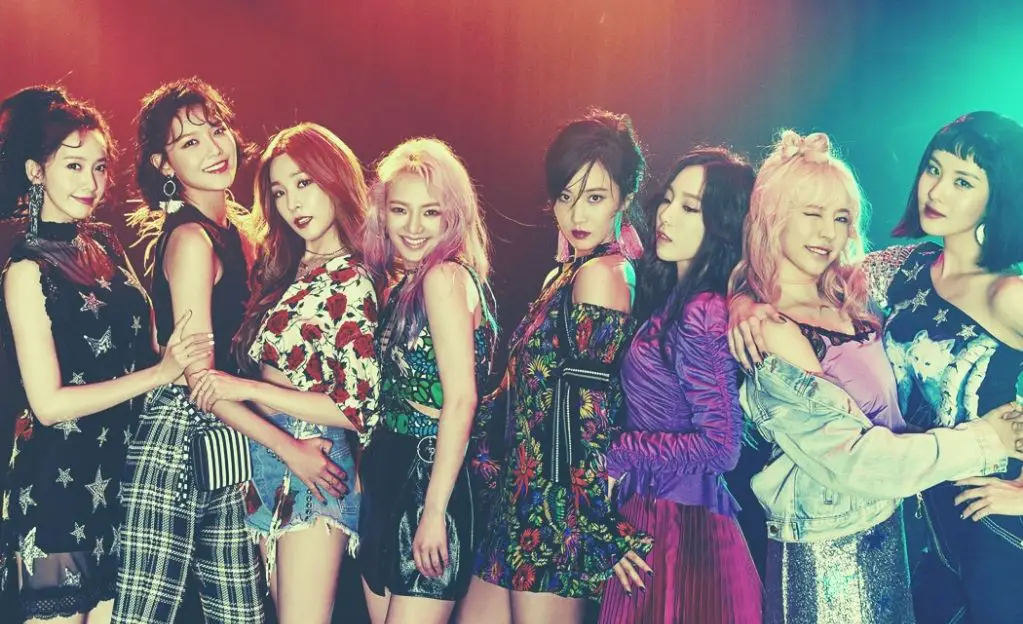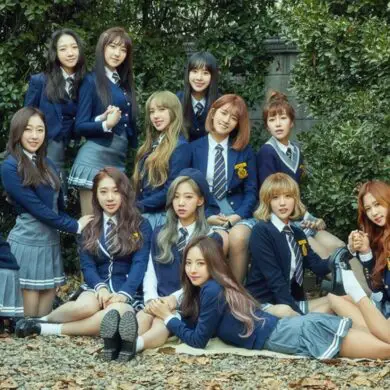Girls’ Generation, also known by their Korean name, SNSD (So-nyuh Shi-dae/Sonyeo Sidae), is an all-female group formed by SM Entertainment. Originally composed of nine members – Taeyeon, Sunny, Tiffany, Hyoyeon, Yuri, Sooyoung, Yoona, Seohyun, and Jessica – the group debuted with their eponymous album, featuring the pre-release single “Into the New World” and the title track “Girls’ Generation”.
In 2014, Jessica left the group and SM Entertainment, while in 2017, members Tiffany, Seohyun, and Sooyoung decided not to re-sign with the agency, although they are technically still part of the group. In 2018, Girls’ Generation debuts a new unit, Oh!GG, composed of the five remaining members signed under SM Entertainment – Taeyeon, Sunny, Hyoyeon, Yuri, and Yoona.
The group’s immense popularity in South Korea has earned them numerous titles such as “The Nation’s Singers” and “The Nation’s Girl Group”. They were also deemed as one of the prominent figures in the expansion of the Korean Wave worldwide, and one of the most popular K-pop groups internationally.
Girls’ Generation is the first Asian girl group to have five music videos recording more than 100 million views on YouTube with “Gee,” “I Got a Boy,” “The Boys,” “Mr. taxi,” and “Oh!”.
2000 to 2008: Formation and official debut
Prior to Girls’ Generation’s official debut, some of the members already had exposure and involvement in the entertainment industry. Member Yoona had infamously gone through about 200 auditions for music videos, dramas, and movies before being lined up as a singer for the group.
Meanwhile, member Sooyoung had exposure to the Japanese music scene as a member of the pop duo Route θ, which disbanded a year after its debut in 2002.
Among all the members of Girls’ Generation, the first to join SM Entertainment as a trainee was Jessica in 2000, after being scouted (together with her sister) by an agency representative in a mall during a family vacation in South Korea. That same year, would-be members Sooyoung and Hyoyeon were cast through the 2000 SM Open Audition.
In 2001, Yuri became an SM trainee after placing second in that year’s SM Youth Best Dancer Competition, while Yoona was cast next through the 2002 SM Saturday Open Casting Audition.
The group’s youngest member, Seohyun, was scouted in a subway by an SM scout, then auditioned in 2003. In 2004, Taeyeon was cast after winning first place in the SM Youth Singing Competition. In the same year, Tiffany auditioned at SM’s Starlight Casting System in Los Angeles, California. The last member to join the group was Sunny, who was initially an SM trainee in 1998 and trained for five years before moving to Starworld, where she trained to debut in a duo named Sugar. Debut plans for the duo, however, fell through, and on the recommendation of Korean-Japanese singer IconiQ, she moved back to SM Entertainment in 2007.
Girls’ Generation had their very first stage performance on Mnet’s School of Rock in July 2007, where they performed their first single, “Into the New World”. And on August 5, they made their official debut on SBS’ Inkigayo, where they performed the same song.
In November 2007, Girls’ Generation released their self-titled debut studio album, which was preceded by the singles “Girls Generation,” a remake of the 1989 song by Lee Seung Cheol, and “Kissing You”. The album sold 56,804 copies upon release and became the 12th best-selling album of 2007 in South Korea.
In March 2008, the group re-released their debut album under the title Baby Baby, which was preceded by the single of the same name released on March 17.
2009 to 2010: Career breakthrough and Japanese debut
Despite gaining attention with their 2007 debut album, it wasn’t until 2009 that Girls’ Generation started gaining popularity.
On January 7, they released their first extended play (EP), Gee, featuring the title track of the same name. The album sold 100,000 copies and took the number one position on KBS’ Music Bank just a week after its release. However, when the group did not appear on the show for unknown reasons, rumors started spreading about a possible misunderstanding between SM Entertainment and KBS.
Still, the song remained on the number one spot for nine consecutive weeks and went on to become the longest-running number one song on Music Bank until 2012 when Psy’s “Gangnam Style” claimed first place for 10 straight weeks. It also became the best-selling single of 2009 in South Korea.
In June 2009, Girls’ Generation released their second EP, Tell Me Your Wish (Genie), along with the lead single of the same name. The EP sold a record-breaking 50,000 copies on South Korea within the first week of release and charted at number 8 on the G-Music chart in Taiwan.
In November 2009, SM Entertainment announced that the group will be embarking on their first concert tour, Into the New World, for which the tickets were sold out in three minutes. The tour kicked off in December 2009 in Seoul, followed by stops in Shanghai and Taipei in April and October 2010, respectively.
In January 2010, Girls’ Generation released their second studio album, Oh!, which peaked on top of the Gaon Album Chart – a first for the group. Prior to its release, the album was also preceded by the lead single of the same name, which took the number 1 spot on the Gaon Digital Chart. “Telle Me Your Wish (Genie)” became the second best-selling digital single of 2010 in South Korea after selling more than 3.3 million copies.
In March 2010, Oh! was re-released under the title Run Devil Run and was again a commercial success in South Korea, topping the Gaon Album Chart upon release and becoming the second and fourth best-selling albums of 2010.
Mid-2010, Girls’ Generation signed with Nayutawave Records (now EMI Records Japan), a division of Universal Music Japan, for their formal entry to the Japanese music scene. The group had their debut release in Japan with the New Beginning of Girls’ Generation DVD, featuring seven of their music videos plus a special bonus footage. The DVD debuted at number four on the Japanese Oricon DVD Chart on August 23, making Girls’ Generation the first Korean girl group to land within the top five spots of the chart. It was certified gold by the Recording Industry Association of Japan (RIAJ), selling 60,000 copies in Japan.
In September 2010, the group released the Japanese version of “Genie” as their debut single in Japan. The song peaked at number four on the Japanese Oricon Singles Chart and was later certified platinum by RIAJ.
Come October, Girls’ Generation released their second Japanese single, “Gee,” which peaked at number two on the Oricon Singles Chart, and became the first single by a non-Japanese girl group to enter the top three of since 1980. “Gee” is also the group’s most successful single in Japan, selling 207,000 copies and being a certified million seller by RIAJ.
In the middle of their Japanese promotions, Girls’ Generation also took part in the SMTown Live ’10 World Tour beginning August 21 at the Jamsil Olympic Stadium in Seoul.
They also released their Korean EP, Hoot, in October 2010, charting on top of the Gaon Album Chart and at number two on the Oricon Album Chart. Hoot eventually became the third best-selling album of 2010 in South Korea. Meanwhile, the title track of the same name debuted on top of the Gaon Digital Chart.
At the 2010 and 2011 editions of Seoul Music Awards, Girls’ Generation won back-to-back awards as Artist of the Year, becoming the fourth act and first girl group to win the category in two consecutive years.
2011 to 2012: Popularity in Japan and international expansion
Girls’ Generation steadily grew their popularity in Japan with the success of the single “Mr. Taxi/Run Devil Run,” after its April 2011 release. The single peaked at number two on the Oricon Singles Chart and became a certified million seller (as of April 2017).
In June 2011, after releasing three singles in Japan, the group debuted their first Japanese studio album and embarked on The 1st Japan Arena Tour, beginning with a performance in Osaka on May 31, 2011.
Girls’ Generation (Japanese version) became a tremendous success, taking the number spot on the Oricon Albums Chart and becoming the first foreign girl group album to top the chart. Just within the first month of its release, the album sold 500,000 copies and earned a double platinum certification from RIAJ.
In December 2011, a repackaged version of the album called The Boys was released, peaking at number five on the Oricon Albums Chart.
By May 2012, Girls’ Generation was a certified million seller by the RIAJ, becoming the first album by a South Korean girl group to earn the achievement. The album also won the Album of the Year award at the 2012 MTV Video Music Awards Japan.
With their extremely successful Japanese debut, the group was viewed as the most popular K-pop girl group in Japan alongside Kara of DSP Media.
In October 2011, the group released their third Korean studio album, The Boys, featuring the title track of the same name, which they promoted on various music shows. The album was also released in the United States by Interscope Records, marking Girls’ Generation’s further international expansion.
As part of their worldwide promotions for The Boys, they made their debut on US television with a performance on Late Show with David Letterman on January 31, 2012 and on Live! with Kelly on February 1. These were followed by a performance on the French television show, Le Grand Journal, on February 9. But while the album was a commercial success in South Korea, it flopped in the United States market.
Come June 2012, Girls’ Generation released their fourth Japanese single, “Paparazzi,” ranking at number two on the Oricon Singles Chart and becoming a certified Gold by the RIAJ. As per SoundScan Japan, “Paparazzi” sold more than 100,000 copies within the first month of release.
In September of the same year, the group followed “Paparazzi” with their fifth Japanese single, “Oh!” The single became the girls’ first number one hit on the Oricon Singles Chart and earned another gold certification by RIAJ for the group.
Two months later, Girls’ Generation released their second Japanese album, Girls & Peace, featuring the two earlier releases – “Paparazi” and “Oh!” – as well as the new single “Flower Power”. The album peaked at number two on the Oricon Albums Chart, sold over 116,000 copies within its first week. And was later certified platinum by RIAJ.
In December 2012, the girls released “Dancing Queen,” a remake of the 2008 song “Mercy” by British singer Duffy. “Dancing Queen” was to be the lead single for the group’s upcoming 2013 Korean studio album.
2013 to 2014: Worldwide recognition and Jessica’s departure
Girls’ Generation released I Got a Boy, their fourth Korean studio album, on January 1, 2013. The album features the pre-released single, “Dancing Queen,” and the second single, “I Got a Boy”.
On the same day of the album’s release, the group held the special television broadcast, Girls’ Generation’s Romantic Fantasy, via MBC.
The album was a commercial success in South Korea, topping the Gaon Album Chart and Billboard’s World Albums Chart. “I Got a Boy,” meanwhile, took the number one spot on Billboard’s Korea K-Pop Hot 100 and the Gaon Digital Chart, and became the 11th best-selling single of 2013 with total sales of more than 1.3 million units. The music video for the song also won the Video of the Year award at the YouTube Music Awards in 2013, beating other nominees Psy and Justin Bieber, and drawing major attention from the Western media.
In February 2013, Girls’ Generation embarked on their Girls & Peace: 2nd Japan Tour, beginning with a performance in Kobe on February 9. This was followed by the group’s first ever world tour, Girls’ Generation World Tour Girls & Peace, which ran from June 2013 to February 2014 and consisted of ten shows in seven Asian countries.
In December 2013, they released their third Japanese studio album, Love & Peace, which was preceded by three singles – “Love & Girls,” which peaked at number four on the Oricon Singles Chart and number 3 on the Japan Hot 100 chart; “Galaxy Supernova,” which peaked at number three on Oricon and number four on the Japan Hot 100; and “My Oh My”. Less than a month after its release, Love & Peace was certified gold by the RIAJ, selling more than 129,000 copies in its first week alone.
In February 2014, Girls’ Generation released their fourth Korean EP, Mr. Mr., featuring the title track of the same name. Upon release, the album immediately took the number one spot on the Gaon Album Chart and debuted at number 110 on the Billboard 200. The lead single also topped the Gaon Singles Chart and sold more than 906,000 copies by the end of 2014.
In March of 2014, they released their first remix album, Best Selection Non Stop Mix, followed by a live album called 2011 Girls’ Generation Tour in April 2013. The remix album charted at number six on the Oricon Albums Chart, while the live album took the number one spot on the Gaon Album Chart.
The Best, Girls’ Generation’s first Japanese greatest hits album, was released in July 2014. The album features the group’s previously released singles, plus four additional tracks: “Indestructible,” “Divine,” “Show Girls,” and “Chain Reaction”. Upon its release, The Best took the top spot on the Oricon Album Chart for two straight weeks, thereby making Girls’ Generation the first non-Japanese all-female Asian group to have three number one albums on the chart.
In the same month, the group completed their third concert tour in Japan, called Love & Peace. The tour commenced with a show in Fukuoka in April 2014 and was followed by 16 more performances in seven Japanese cities, including Osaka, Nagoya, and Tokyo. The conclusion of the Love & Peace tour also brought the total number of spectators in three Girls’ Generation concert tours to 550,000, setting the record for any K-pop girl group at the time.
On September 29, 2014, Girls’ Generation was hit by a huge controversy when member Jessica announced that had been dismissed from the group. SM Entertainment confirmed the news, stating Jessica was no longer a member of Girls’ Generation due to conflicts between her personal schedules and the group’s. From then on, Girls’ Generation promoted as a group of eight.
On December 9, the group held The Best Live concert at Tokyo Dome in front of 50,000 fans, their very first concert with eight members.
2015 to 2016: More album releases, reality television program
In March 2015, Girls’ Generation announced the release of the single “Catch Me If You Can,” their first release since Jessica’s departure. The song was recorded in both Korean and Japanese, with the Korean version being released worldwide on April 10 and the Japanese version being released 12 days later.
“Catch Me If You Can” peaked at number 19 on the Gaon Digital Chart and number eight on the Oricon Singles Chart.
On August 19, 2015, the group released their fifth Korean studio album, Lion Heart, featuring the title track of the same name. The album topped the Gaon Album Chart and ranked at number 11 on the Oricon Albums Chart. The release of Lion Heart spawned three singles from the group – “Party,” which peaked at the top of the Gaon Digital Chart, number ten on the Japan Hot 100, and number four on Billboard’s World Digital Songs; “Lion Heart,” and “You Think,” which charted at numbers four and thirty on the Gaon Digital Chart, respectively.
As part of their promotions for Lion Heart, the girls starred in their own reality television program, titled Channel Girls’ Generation. The group also kicked off their fourth concert tour, Girls’ Generation’s Phantasia, with a performance in Seoul on November 21, becoming the first South Korean girls group to hold a fourth tour.


